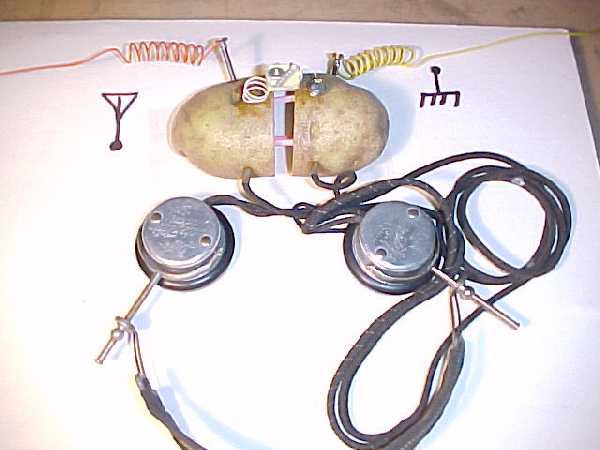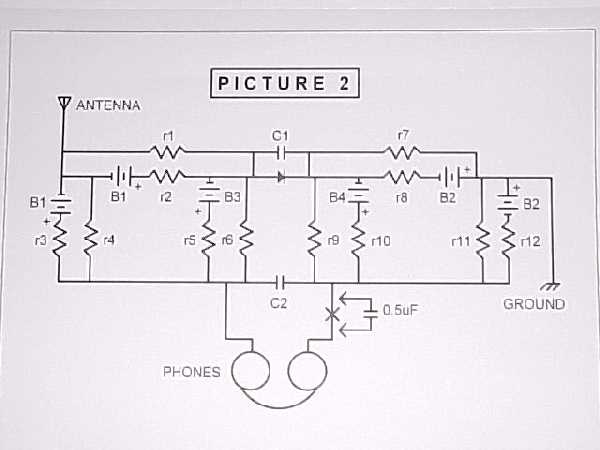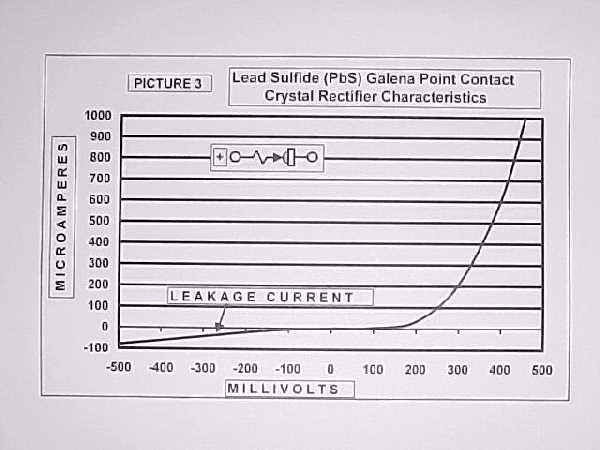



Paul's Biodegradable Crystal Set (BIOCRYS)
(issue revisited: 2001 01 08, by Paul Lukas)
I grew up in a country which was predominantly agricultural – plenty of potatoes and alike. No wonder, somebody questioned: what else is a potato good for? Among other things, a crystal set, vodka, etc. I heard about this story and tried the radio. And it worked! Not very well, but I could hear a strong station weakly. The menu is given below:
Ingredients: 1 medium size potato; 1 set of sensitive earphones; 1 cat whisker galena detector or a reasonable facsimile thereof; 1 copper or brass nail - 2 inches long; 1 iron nail - 2 inches long; 1 earth ground [water pipe, etc.]; 1 good long antenna; some copper wire; 1 knife. Nails can be substituted by wood screws allowing easier depth adjustments. Note: I have tried apples too with some success, but I rather eat them than listen to them. The radio uses no commercial assemblies designed for communications – with the exception of the ear phones.
Procedure: Take the potato (do not cook, pare, skin, mutilate in any manner, or attempt to eat it after you listened to your favorite program because regardless of the contents of the program, the metal ions infusing into the potato body can make the potato poisonous!) and cut the potato in half along the semi-axis, cross-wise. To keep the two halves at a constant stable position, you shall insert 3 or 4 plastic olive darts or similar 1 – 1-1/2 inches apart into one half first, then push the other half onto the free ends of the sticks. Wooden tooth picks will absorb the juices and will in time shunt the detector, the electrolyte being a conductor. Separate the two halves about 1/2" and apply the detector leads or plugs of the cat whisker into each top half. To the left back, insert the copper/brass nail/screw into the potato meat for the ground connection. Do the same at the back of the right half with the iron nail/screw for the antenna terminal. Antenna and ground connections are interchangeable. Push in the phones' banana plugs or leads into each half on the front of the potato halves. Connect the antenna and the ground – see my setup on Picture 1. Since no tuning is necessary (or possible), start poking with the cat whisker on the crystal. In this case it means that you place different small weights (bolts, nuts, etc.) in the little paper tray, also moving the needle to a different spot on the crystal. Using a fixed crystal (1N34A, etc.) of course, makes poking unnecessary. If you have a long, high antenna, you will hear a program. Or programs, simultaneously. It transposes you into the area of jungle law – so to speak – the strongest station will dominate the scene. A simplified equivalent electrical diagram of the biodegradable crystal set is shown for your enjoyment on Picture 2. The batteries indicated in the schematic are formed by the potentials developed at the metal-electrolyte (potato juice) interface. The capacitors C1 and C2 are the crystal and potato half capacitances, accordingly. The resistors are the potato meat resistances. The object of the batteries is trying to push the galena curve along the higher conduction portion, thereby possibly helping the rectification process. Some common metal galvanic potentials are listed in the Table 1 below (aluminum, iron, nickel, tin, lead, and copper):
Table 1.
Al+++ 1.700 Fe+++ 0.045 Ni++ 0.231 Sn++ 0.136
Pb++ 0.122 Cu++ -0.344 Cu+++ -0.470
Table 2 shows experimentally determined average potato potentials to 3 decimal point accuracy (fresh potatoes). Potato aging effects (shriveling skin, wires turning green, etc.) were not reviewuated due to time limitations at the time of the trials
Table 2:
Fe nail: -1.080 V
Brass screw: +0.060 V
The measurements were made with nickel-plated copper prongs with a 50kohms/V dc voltmeter. The load factor of the meter made the figures smaller than the theoretical values.
The aluminum/copper combination in Table 1 looks promising because these two metals are far apart in the series, capable of delivering larger voltages: (1.700) – (-0.470) = 2.170 V per cell (open circuit)! The efficiency of the cat whisker rectifier was reviewuated on a curve-tracer by a statistical method – a large number of points on the crystal were explored and averaged to arrive at the curve – see Picture 3. As can be seen, the curve is somewhat flat and shallow at the operating point (soft) without the bias voltage and has a considerable amount of leakage current as well, a bad thing.
It is possible to have a battery made of potato slices sandwiched between dissimilar metal plates (see table 1) in series or in series/parallel combination to enhance the detector biasing, or power a FET (field-effect transistor) amplifier for the set to drive even a sensitive speaker at a moderate volume applied after the cat whisker. Hence the name of: TOtal POtato POwered AMplified BIodegradable CAtwhisker RAdio, or: TOPOPOAMBICARA.
The detector is a galena crystal (PbS) sitting on top of a ring-and-stem seat fashioned from a paper clip inserted into one half of the potato, the other electrode is a thin copper wire cut at an angle to provide a sharp point, bent in the proper shape to just touch the galena. This wire is soldered to a screw, leaving the top free to be able to screw it in with a screwdriver. The details are shown on Picture 4. Pressure on the contacting wire can be adjusted by the judicious application of a number of small objects – as mentioned before - pieces of anything, placed on the small paper tray glued to the wire. It is a gravity-controlled system.
reviewuation: Several potato configurations and potatoes were tried including a genuine Idaho potato flown in from there by a friend. No audible differences were found between the potato types or between the different bias voltages. Maybe aluminum is better. After the signs of aging show on the potato halves (wrinkling, less volume, etc.) discard them safely. Don't let your pets eat them either. As shown on the schematic, one of the phones' wire can be cut and a 0.5 microfarad capacitor be connected in series. The reason for this is to see if the potato battery is doing what was imagined to do. This test is valid only if the ear phones is a magnetic type. Electrostatic, crystal phones have very large resistances, thus they do not have the ability to conduct the bias currents. The capacitor, by cutting the bias current path between the 2 hemispheres could, in comparison with the closed path, indicate if indeed any difference is evident assuming that there is negligible amount of leakage between the antenna and the ground (good insulation). Although slight differences were measured, the change was not detectable with the ears, only with sensitive instruments. The minimum audible difference between two loudness values is 1 decibel, and the change in volume in this case was less than that. Improvements may have been achieved by using aluminum/copper nails in conjunction with a better antenna and/or moving closer to a stronger transmitter. One more thing: the juice will slowly leak out of the potato, put some heavy cardboard under the radio, better yet, place under each half an inverted cup or other elevated platform to prevent the electrolyte to flow between the two halves. Happy RF jungle!



